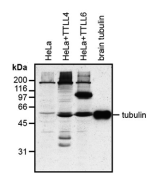Cookie Policy: This site uses cookies to improve your experience. You can find out more about our use of cookies in our Privacy Policy. By continuing to browse this site you agree to our use of cookies.
AdipoGen Life Sciences
anti-Polyglutamylation Modification, mAb (GT335) (Biotin)

| Product Details | |
|---|---|
| Synonyms | Polyglutamylated Tubulin; Glutamylated Tubulin; Postranslational Protein Glutamylation |
| Product Type | Monoclonal Antibody |
| Properties | |
| Clone | GT335 |
| Isotype | Mouse IgG1κ |
| Source/Host | Purified from concentrated hybridoma tissue culture supernatant. |
| Immunogen/Antigen | Octapeptide EGEGE*EEG, modified by the addition of two glutamyl units onto the fifth E (indicated by an asterisk). |
| Label/Conjugates | Biotin |
| Application |
Immunocytochemistry: (1:2000) |
| Crossreactivity | All |
| Specificity |
Recognizes the posttranslational modification (poly)glutamylation on proteins. Reacts with polyglutamylated α- and β-tubulin. |
| Purity | ≥95% (SDS-PAGE) |
| Purity Detail | Protein G-affinity purified. |
| Concentration | 1mg/ml |
| Formulation | Liquid. In PBS containing 0.02% sodium azide. |
| Isotype Negative Control | |
| Other Product Data |
Recognizes most forms of polyglutamylated tubulin (α- and β-tubulin), independent of the length of the glutamate side chains. No specificity to particular tubulin isoforms nor to tubulin from particular species are observed. Detects also other (poly)glutamylated proteins. Since no consensus modification site is known for protein (poly)glutamylation, the detection is not sequence-specific. However, an acidic environment of the modification site is required. |
| Shipping and Handling | |
| Shipping | BLUE ICE |
| Short Term Storage | +4°C |
| Long Term Storage | -20°C |
| Handling Advice |
After opening, prepare aliquots and store at -20°C. Avoid freeze/thaw cycles. |
| Use/Stability | Stable for at least 1 year after receipt when stored at -20°C. |
| Documents | |
| MSDS |
 Download PDF Download PDF |
| Product Specification Sheet | |
| Datasheet |
 Download PDF Download PDF |
Polyglutamylation is a post-translational modification in which glutamate side chains of variable lengths are formed on the modified protein. It is evolutionarily conserved and the most prominent substrate is tubulin, the microtubule (MT) building block. Polyglutamylation has been proposed to be involved in the functional adaptation of MTs, as it occurs within the carboxy-terminal tubulin tails that participate directly in the binding of many structural and motor MT-associated proteins. The recent identification of new substrates of polyglutamylation indicates that this post-translational modification could be a potential regulator of diverse cellular processes and be involved in cell cycle and cell proliferation.
- Distribution of glutamylated alpha and beta-tubulin in mouse tissues using a specific monoclonal antibody, GT335: A. Wolff, et al.; Eur. J. Cell Biol. 59, 425 (1992)
- Polyglutamylation of nucleosome assembly proteins: C. Regnard, et al.; J. Biol. Chem. 275, 15969 (2000)
- Glutamylated tubulin: diversity of expression and distribution of isoforms: M.L. Kann, et al.; Cell Motil. Cytoskeleton 55, 14 (2003)
- Polyglutamylation Is a Post-translational Modification with a Broad Range of Substrates: J. van Dijk, et al.; J. Biol. Chem. 283, 3915 (2008)
- Unique post-translational modifications in specialized microtubule architecture: K. Ikegami & M. Setou; Cell Struct. Funct. 35, 15 (2010) (Review)
- Tubulin detyrosination promotes monolayer formation and apical trafficking in epithelial cells: S. Zink|et al.; J. Cell Sci. 125, 5998 (2012)
- The CP110-interacting proteins Talpid3 and Cep290 play overlapping and distinct roles in cilia assembly: T. Kobayashi, et al.; J. Cell Biol. 204, 215 (2014)
- CNS axons globally increase axonal transport after peripheral conditioning: F.M. Mar, et al.; J. Neurosci. 34, 5965 (2014)
- Microtubule detyrosination guides chromosomes during mitosis: M. Barisic, et al.; Science 348, 6236 (2015) (Supplement)
- SAS-6 engineering reveals interdependence between cartwheel and microtubules in determining centriole architecture: M. Hilbert, et al.; Nat. Cell Biol. 18, 393 (2016)
- Loss of RPGR glutamylation underlies the pathogenic mechanism of retinal dystrophy caused by TTLL5 mutations: X. Sun, et al.; PNAS 113, E2925 (2016)
- Alterations in the balance of tubulin glycylation and glutamylation inphotoreceptors leads to retinal degeneration: M. Bosch Grau, et al.; J. Cell. Sci. 130, 938 (2017)
- The actin-MRTF-SRF transcriptional circuit controls tubulin acetylation via α-TAT1 gene expression: J. Fernández-Barrera, et al.; J. Cell Biol. 217, 929 (2018)
- iPSCs from a Hibernator Provide a Platform for Studying Cold Adaptation and Its Potential Medical Applications: J. Ou, et al.; Cell 173, 1 (2018)
- Klf4 glutamylation is required for cell reprogramming and early embryonic development in mice: B. Ye, et al.; Nat. Commun. 9, 1261 (2018)
- Centrosome amplification arises before neoplasia and increases upon p53 loss in tumorigenesis: C.A.M. Lopes, et al.; J. Cell. Biol. 217, 2353 (2018)
- Differences in Intrinsic Tubulin Dynamic Properties Contribute to Spindle Length Control in Xenopus Species: W.G. Hirst, et al.; Curr. Biol. 30, 2184 (2020)
- The Musashi proteins MSI1 and MSI2 are required for photoreceptor morphogenesis and vision in mice: J. Sundar, et al.; J. Biol. Chem. 296, 100048 (2021)
- ER proteins decipher the tubulin code to regulate organelle distribution: P. Zheng, et al.; Nature 601, 132 (2022)
- A high-throughput electron tomography workflow reveals over-elongated centrioles in relapsed/refractory multiple myeloma: T. Dittrich, et al.; Cell Rep. Methods 2, 100322 (2022)
- Polyglutamylation of microtubules drives neuronal remodeling: A. Gavoci, et al.; Nat. Commun. 16, 5384 (2025)






